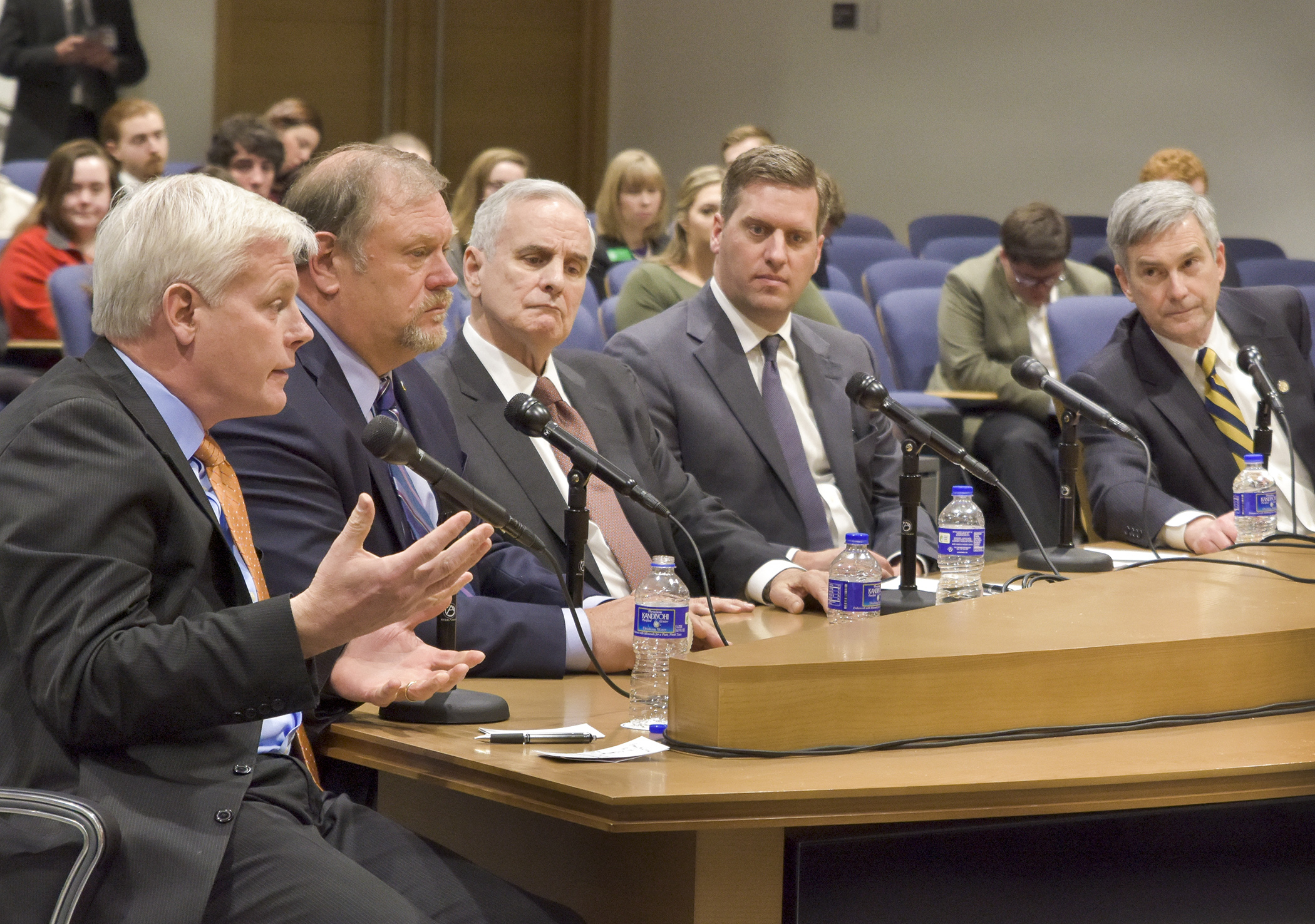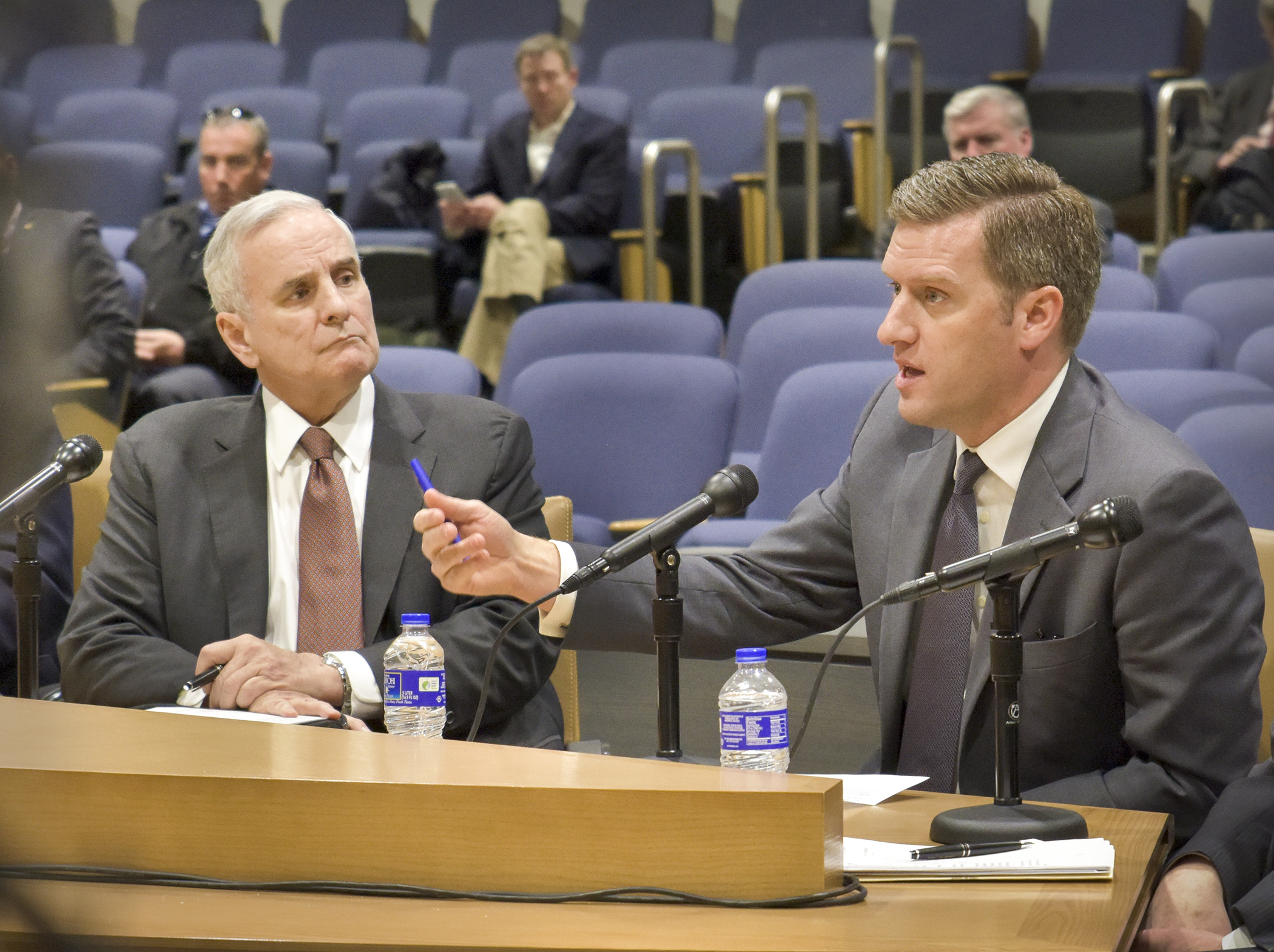Gov. Dayton, legislative leaders lay out 2016 session plans

Will this be the year the Legislature and Gov. Mark Dayton agree on a large, long-term funding package to upgrade the state’s transportation system?
Will a comprehensive tax bill be agreed upon? How about a hundreds-of-millions of dollars capital investment bill? Unemployment assistance for laid-off Iron Range miners? Real ID compliance?
To get the work done, lawmakers and the governor have just under 11 weeks from the March 8 start date of the Legislative session to May 23, the day they must constitutionally adjourn for the biennium. At an often-combative preview, legislative leaders from both sides of the aisle and the governor struggled to express confidence Thursday that much agreement can be reached on key issues in a relatively short time span. The event was sponsored by Forum News Service.
[Watch the legislative preview courtesy of Senate Media Services]
Transportation
“There are two things on which most Minnesotans agree: we need to make a greater investment in improving our roads, bridges, public transit. The second is nobody wants to pay for it,” Dayton said. “I want to see what others in the Legislature have to offer, but I insist that it be real and that we not gut the General Fund and shift $500 million a biennium out of the General Fund for transportation.” Secondly, he wants a plan that secures ongoing revenue.
A House Republican-backed plan would raise an additional $7 billion in the next decade, in part, by redirecting motor vehicle-related tax revenue, such as on auto parts and rental cars, away from the state’s General Fund, identifying efficiencies in the Department of Transportation budget and utilizing some of the state’s projected $1.2 billion budget surplus.
Meanwhile, a Senate DFL plan, proffered last session, calls for an $11 billion infusion by instituting a new gas tax and expanding a metro area transit-dedicated sales tax from one-quarter to three-quarters of a cent.
“There’s no free lunch, it’s got to come from somewhere,” Dayton said. “Are Minnesotans willing to pay one way or the other … or are you willing to live in a state where highway construction, roads and bridges continue to get worse.”
“I’m optimistic (we’ll get a plan),” said House Speaker Kurt Daudt (R-Crown), who encouraged both sides to focus on what they can agree on, namely road and bridge repair. “Everyone here talks about transportation being their priority.”
Yet, the idea of plans crashing remains real.
Daudt said transit funding is not an area of agreement, and said there may not be enough votes in the House to pass such spending.
House Minority Leader Paul Thissen (DFL-Mpls) countered that funding transit is “controversial in the Tea Party wing of the Republican Party, but it’s broadly supported by people in Minnesota. They know we can’t just build roads and bridges.”
Senate Majority Leader Tom Bakk (DFL-Cook) is “pretty pessimistic” a comprehensive transportation plan can be reached this session, but he urges caution if one is.
“I don’t want to end this session with a bunch of one-time money out of the surplus and everyone go home on the campaign trail and say they’ve resolved our transportation needs. I do think we need to be cautious about committing General Fund money going forward. … Both sides are going to have to be willing to consider something that the other side wants and probably have to be willing to do something that they might be a little uncomfortable with to get something that they want.”
Taxes
Last year’s omnibus tax bill (HF848) stalled in conference committee at the end of session. Its fate was linked to the inability of the Legislature and governor to reach agreement on a comprehensive transportation bill.
Critics of last year’s tax bill said the House-proposed $2 billion in tax relief was so high that it made spending in other areas of the state budget nearly impossible, and would set the stage for state budget deficits in later years. Supporters, however, said the proposals were long overdue and go straight to what they say is much-needed tax relief for small businesses and middle-class families.
 Gov. Mark Dayton, left, and House Speaker Kurt Daudt have a spirited exchange about taxing social security during a 2016 legislative preview Feb 25. Photo by Andrew VonBank
Gov. Mark Dayton, left, and House Speaker Kurt Daudt have a spirited exchange about taxing social security during a 2016 legislative preview Feb 25. Photo by Andrew VonBankWe’d like to focus on getting more money into the pockets of Minnesota families, not the state budget, Daudt said.
In particular, he and Senate Minority Leader David Hann (R-Eden Prairie) mentioned not taxing Social Security income.
“All Social Security income is exempt, is not taxed, for those at the lower income level. It’s partially taxed at the next level and then taxed at the same rate as the feds, 85 percent, at the top level,” Dayton said. “You’re not helping those in the lower-middle and lower income levels. I would agree that the middle level income ought to be raised.”
The governor also said he’ll propose an increase in the income level for the working family tax credit.
Bonding
Traditionally, the second year of the biennium is focused on capital investment spending; however, the issue was not addressed other than Daudt saying he’d like to see a bill that is heavy in transportation and Bakk saying he’d like to see a “robust” bill supplemented with some one-time cash.
Funds for facilities maintenance at Minnesota universities, rail safety improvements and renovations at the troubled state security hospital are among the items on a $1.4 billion bonding wish list Dayton unveiled last month.
MORE: See the governor’s full list of proposed bonding projects here
Some legislators have expressed unease with bonding proposals that surpass $1 billion, and others have suggested recently the state should use some of its projected $1.2 billion budget surplus to fund capital projects in place of additional borrowing.
A $373.4 million bonding law passed during last year’s special session funded upgrades at a pair of food safety labs, flood mitigation and disaster relief projects and helped complete renovations to the State Capitol.
Other issues
Leaders on both sides believe a bill to extend unemployment benefits to laid-off Iron Range miners will be passed in the first week of session, but Daudt would like to see ideas that address ways to grow the economy in northern Minnesota on a long-term basis.
Daudt said some language regarding the Real ID issue is also expected to be acted upon early. If the state does not come into compliance with the standards, Minnesotans could be unable to board a commercial domestic flight using only their state-issued non-enhanced IDs. That has led to concern and confusion among some would-be travelers, though the federal government has said it will give state officials at least 120 days’ notice before enhanced IDs are required to pass security for domestic flights.
Bakk indicated a plan to reduce racial disparities should be ready when session starts, but admitted there might be a narrow window to pass significant changes for this biennium.
The state’s prisons are currently filled beyond capacity, and a task force has been meeting to address the issue. A recent report by the Sentencing Guidelines Commission recommended lessening some sentences, especially in the area of drug crimes.
Dayton believes it will be a tough issue to address this session, while Bakk said the issue is a conversation worth having. Daudt indicated a solution would be having inmates housed at the now-vacant prison in Appleton that is privately owned, but is being maintained. Thissen said if that is a solution, the state should buy and operate the facility.
Related Articles
Search Session Daily
Advanced Search OptionsPriority Dailies
Ways and Means Committee OKs proposed $512 million supplemental budget on party-line vote
By Mike Cook Meeting more needs or fiscal irresponsibility is one way to sum up the differences among the two parties on a supplemental spending package a year after a $72 billion state budg...
Meeting more needs or fiscal irresponsibility is one way to sum up the differences among the two parties on a supplemental spending package a year after a $72 billion state budg...
Minnesota’s projected budget surplus balloons to $3.7 billion, but fiscal pressure still looms
By Rob Hubbard Just as Minnesota has experienced a warmer winter than usual, so has the state’s budget outlook warmed over the past few months.
On Thursday, Minnesota Management and Budget...
Just as Minnesota has experienced a warmer winter than usual, so has the state’s budget outlook warmed over the past few months.
On Thursday, Minnesota Management and Budget...